I recently had the opportunity to travel to New Orleans, and spent some time in two different military museums there (of course!). One was the massive National World War II Museum founded by Stephen Ambrose, and the other was the much smaller and much older Confederate Memorial Hall Museum. They are virtually across the street from each other, and are both worth a visit for folks who are in the city – but they are very different places and I think the contrast is interesting.
The WWII Museum is a whole campus of buildings; 6 acres if I remember correctly. They are adding more buildings, with several new exhibit halls expected to open in the next year or two. At the moment, there are two main halls: the US Freedom Pavilion (which houses a couple vehicles and a number of aircraft) and the Louisiana Memorial Pavilion. The Louisiana Memorial Pavilion is the main event, with three floors of exhibits covering the major theaters of the war. The museum was originally dedicated specifically to the D-Day invasion of Normandy, and later received congressional status as the nation’s official overall WWII museum – so the staff had quite a job in expanding the coverage from a single operation to a whole war.
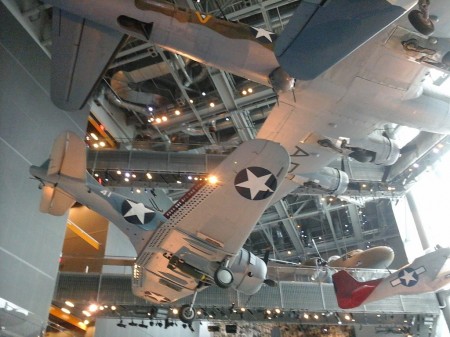
The overall layout of the museum was based on Stephen Ambrose’ vision, and shows the main flow of the war in broad strokes supported by anecdotal events and associated artifacts from individual veterans. This very personal touch is a very effective way to help bring the events to life for visitors who don’t have the deep background understanding of the war that most folks reading this likely have.
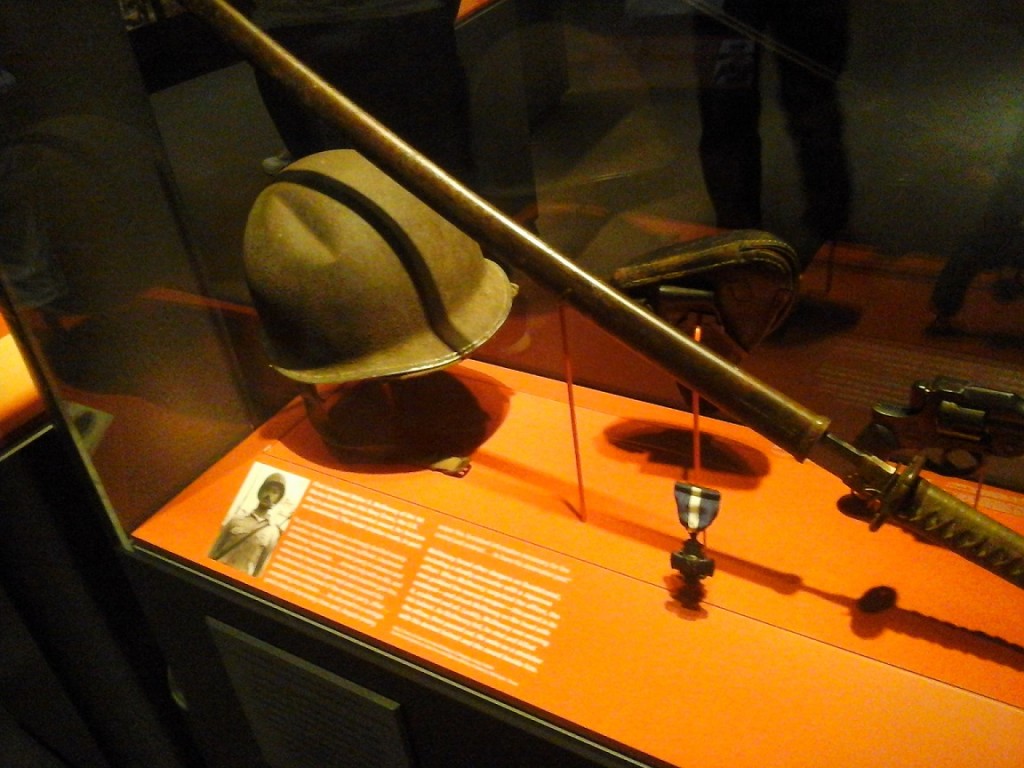
Museum design in general has changed in years past, and the National WWII Museum is a picture-perfect example of the new school of museum design. It is set up for people who have little or no knowledge of the war, and guides them through from the beginning to the end like a multimedia textbook, doing its best to provide an all-encompassing understanding of “what was WWII?” Instead of focusing on the boring stuff of academic classes, like a multitude of names and dates, it conveys a more generalized feel for how the war progressed and what its impact was on both combatants and non-combatants. The artifacts on display are generally chosen for their connection to a specific individual soldier and his story, which is a nice touch. In addition, much use is made of video, both original wartime footage and oral history interviews with veterans many decades after the war. I think this type of media is an essential element in a museum of this style, as it gives the viewer a firsthand look at the events much deeper than one can get from looking at artifacts.
If I have a complaint about this museum style, though, it is the focus on events to the exclusion of artifacts. Once you are familiar with the story being presented and the personal anecdotes chosen to accompany it, there is not much more you can learn from this sort of museum – and if you are reading this web site, the chances are pretty good that you already have a much deeper understanding of WWII than the museum presents (and I should also point out that this is an American WWII museum – it only touches on areas with US activity. There is no mention of the Eastern Front, for example.). In this case, you may be interested in some of the vehicle displays (a Sherman, Jeep, Dodge 3/4 ton ambulance, Hurricane, DC-3, B17, and a few other aircraft) but you will not find very much of interest in the exhibits. You will, in fact, find the history to be rather propagandized and simplified. More than a few of the weapons on display are actually dummies, some built better than others. Actually, the most unusual and interesting (to me, anyway) firearms on display is a Japanese trainer version of the Type 96 Nambu. It is being used as a stand-in for a real Type 96, and labelled as being a blank-firing trainer pressed into service with live ammo at the end of the war (which I really doubt; it appears to be a simply blowback action that would blow itself apart on the first live round). Frankly, these are much harder to find than real Type 96s, and it was cool to see one on display.
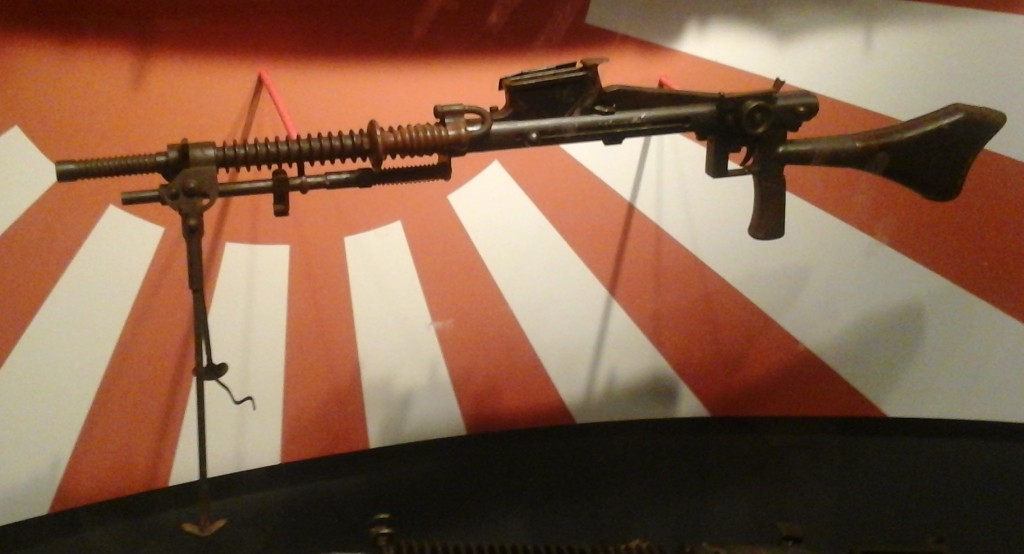
A perfect example of the older style of museum design is actually right across the street from the National WWII Museum campus: the Confederate Memorial Hall Museum.
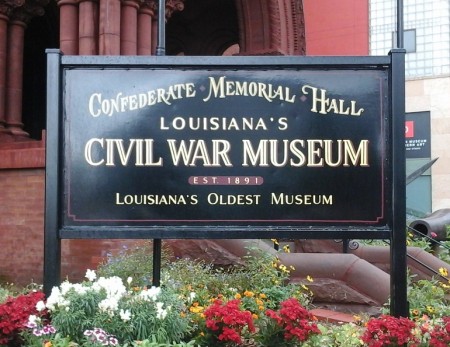
Established way back in 1891, it is of the “piles of artifacts” school of museum design. There is some explanation of what things are, but in order to get the most out of this place you will need to do background research before you set foot in the door – and the more you know, the more you will learn here (as opposed to the WWII museum, where those who learn the most are those who enter knowing the least).
This museum is chock full of uniforms, firearms, equipment, and other assorted artifacts of the Civil War, with a strong focus on the Confederacy. It is much more densely packed than more modern museums, and frankly I like that. I wish I could have taken photos inside, but their photography policy (none at all, under any circumstances!) is rather paranoid. I
did find this photo of the main room on their own web site, though, and it gives a decent feel of the place:
There isn’t a whole lot more I can think of to say about the Confederate Memorial Hall, except that my lack of commentary is not a reflection of a sparse museum, but rather just that there isn’t a whole lot that needs to be said. If you are interested in the Civil War and the Confederacy and have the chance to visit, you should definitely do so. The admission price is $8, the staff is friendly and helpful (although not particularly knowledgeable, unless you catch the curator), and their small gift shop book store is better stocked than the WWII museum.
I suppose there is a bit of an elephant in the room with today’s political climate about the Confederacy and racism, so I should say that it is really a non-political place. Hundreds of thousands of poor bastards died fighting for the Confederacy just as hundreds of thousands of others did for the Union, and this museum is there to remember them and share their story – not to make political statements.
I have been trying to figure out a more diplomatic way to say this, and haven’t been able to, so I’ll just be blunt. Many modern museums, including the National WWII Museum, are designed for the lowest common denominator. Walk in as a completely blank slate, and you will walk out with a basic overall view of American activity in World War II. Walk in as a subject matter expert, and you will find yourself moving from room to room fairly quickly, and wrinkling your brow at some of the simplifications (and having fun spotting the dummy guns in displays). Older museums, like the Confederate Memorial Hall, don’t hold your hand – but also don’t limit what you will learn if you know what to look for. For most people, the new style will, like a textbook, deliver the most information to the greatest number…but for the people really interested in a subject the old methods are much more rewarding. So which museum should you visit? It entirely depends on who you are and what you are looking for.

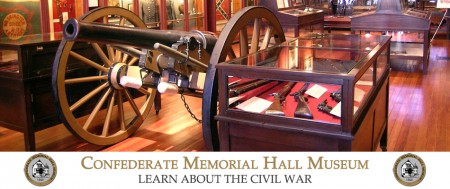
Every museum I´ve ever visited have proved to be somewhat of a disapointment, just because of the small amount of information there is. I put it like this, you get no deeper understanding in things.
I apreiciate your rewievs both on books and museums as well as on guns, keep up the good work.
If you ever make it to Yankee Country (Cuomostan) the USMA Museum in Highland Falls NY has a ton of prototype and rare weapons. They may even let you get into the back rooms. I still have some contacts there if you are interested. Lots of stuff not on display but accessible with a special pass.
I applaud the way this report is written – frank and capturing reality of the day, not necessarily reality of war(s). Those are obviously two different subjects. Portraying war as a seamless continuation of politics by different means is very rarely mentioned.
Yes, It is true that U.S. war cake-walk (well, not quite..) with Japan is always seen as the dominant (as if no one else was at war even more damaging) and let it be so. After all the “objective was accomplished” and Japan had been fully subjugated into non-coherent cultural conglomerate. Fine by me, I like their motorcycles and cars.
The U.S.Civil war is also a nifty subject and I have remained in ongoing amusement how it is sold to public without touching on underlying issues at all; just the romance part. Racism? What racism?!
Lets go back to guns, shall we chaps?!
Great observations, Ian. Both museums are local to me. I have spent a good deal of time in each one, and I find your assessments to be spot on. The WW2 museum has been a good resource for those unfamiliar with the details of the war and those who have local connections (i.e. Higgins Boat Works). One thing I have noticed is that for many who go to the WW2 museum, they leave with a sense of melancholy (both those unfamiliar with the war and those who remember it either from childhood or as veterans) OTOH, I went with some friends a while back and after viewing the weapons displays, one said to me, “Dude, you’ve got way more stuff than they do!” . The Civil War museum is a literal treasure that contains the most valuable collection of Confederate regimental flags assembled in a single location. That wonderful collection was almost lost to political correctness after Katrina, when the city wanted the collection dispersed and the space converted to a “contemporary arts” museum. The facility was saved, for now, but many locals want to see it shut down. The greatest tragedy was the loss of much of the collection at the Louisiana Military Museum at Jackson Barracks in Chalmette. Aircraft, Vehicles (including a running Renault FT), arms, documents, and artwork were completely destroyed by the flooding from Hurricane Katrina. Volunteers are trying to restore what they can, but much was completely destroyed. Ian, I hope you enjoyed your time down here, and there is a lot more to see (Fort Jackson, the Chalmette battlefield, the Houma Regional Military Museum, and many others. BTW, the food ain’t too bad, either.
I really hope that the confederate museum never gets dispersed and for a contemporary arts museum?? people need to learn about and keep around the history of where they live even if the confederacy did support slavery its still history and need to be kept around.
Michael,
New Orleans already has at least 3 “contemporary art” museums, so this effort was a bit of political grandstanding by a former mayor (who is soon to be a long-term guest at Club Fed) and one of his wealthy supporters who were pandering to a certain voting bloc. Enough of us rallied and donated a lot of money to keep the museum as it is. We had a lot of outside support from Civil War historians and re-enactor groups both North and South to preserve this amazing collection of relics. (The museum was established only 20-odd years after the war ended, so the flags, uniforms, and weapons are in almost pristine condition) They even wanted to tear down the old Confederate Hall and replace it with some god-awful glass and steel post-industrial eyesore full of “art” composed of work that wouldn’t qualify as fit to be magnetically attached to the family refrigerator! The collection is safe, for now, but I fear it will always remain threatened in this political climate. I am glad that Ian was able to see it and post about it here, and I encourage everyone who has the chance to go and spend an afternoon there. The more people who visit, the better the chance that it will be saved. It was heartening to see a positive TV spot on the museum last night on our local PBS channel that emphasized the unique nature of the museum and its importance to our understanding of the Civil War. As for choosing sides, I had ancestors who fought for both the Union and the Confederacy, so I don’t really have an axe to grind, there. I do, however, have fond memories of my grandfather taking me through the museum as a child, and telling me stories about my ancestors and their service in those days. I have a lot of personal diaries and memoirs from their time in the war, and will be writing a book about it at some point. As for now, if you are ever in New Orleans, that museum is a must-see.
If you really want to go to a lowest common denominator museum, try the National Museum of Nuclear Science & History in Albuquerque. I think you leave knowledge behind. The total opposite is true for the Bradbury Science museum up in Los Alamos, great place.
This topic really hits home, as I have some experience with the Natural History side of the museum game. There has been a lot of debate in the last few years with regard to “modern museums,” with a couple of good viewpoints at: http://drvector.blogspot.co.uk/2007/09/i-am-not-muse-d.html (some harsh language, but a really great discussion in the comments)
I use one criterion to judge museum exhibits: “What am I getting out of this that I wouldn’t read from the article on Wikipedia?” Basically, what is the point in traveling, fighting crowds, and paying admissions fees to learn something I could have found in fifteen minutes on the internet. If I am in a museum I want to see real specimens and objects with my own eyes, not read some crap off a TV screen or look at blown up pictures of stuff. The sad thing is how many exhibits fail this test. On the other hand I have also seen some really nice exhibits, often at little regional museums which don’t have any name power or wider renown. It all comes back to showing the visitor things that they can’t just find on Google.
I like the visit the gun museum at Chickamauga National Battlefield. They have a full run from colonial weapons all the way up to WW1. You done learn much about that is what Forgotten Weapons is for.
Ian,
If I’d known you were around I’d have loved to get you a drink!
Well if anyone finds themselves in the Southern Hemisphere I can highly recommend the Australian War Memorial, I’ve been there twice and I’d say it strikes a good balance between the two ‘styles’ of museum. Has a lot of artifacts, but also does a good job incorporating soldiers experiences as well. And even briefly covers areas that Australia wasn’t involved (it has an example of the Soviet winter uniform on display for example, even though I’m pretty sure there were no Aussies involved on the eastern front.) http://www.awm.gov.au/exhibitions/
that said I am a little obsessed with that area of history, when me and my wife visited, my father recommended just dropping me off for five hours and going off and doing something else – my wife agreed!
I couldn’t agree more on the two types of museum thing. It was made extremely and sadly apparent on a recent trip to the smithsonian museums in DC. If you are a child or know little ,they tell a good story, but if you do know something, it’s ” please, enough with the videos, where is the STUFF”
I have thought alot about making a 1400 mile trip Just to see the WW II museum. Now I will go there only if I get an irresistible urge for Jambalaya or Crawfish Pie.
Yeah, I would not recommend making the trip just for that museum. In fact, the best museum I had the chance to visit in the area was the battleship USS Alabama, docked in Mobile. I’ll be doing a writeup on that in a few days; it was an outstanding experience.
The Alabama was my favorite as well. My grandparents lived about an hour away and I always begged them to take me to “see the battleship.” Heck, my wife still has a scar on her forehead from hitting the edge of a watertight door on the U.S.S. Drum when she was a kid. That boat taught me early in life that I wasn’t cut out to be a submariner. I haven’t been back in a long time. Glad to hear it’s still a good experience. Now I have to take a road trip to Mobile (and get some ‘erstas at Wintzell’s).
In New England, we’ve just seen a museum of rare armor and weapons from antiquity through the middle ages subsumed in an art museum, which is keeping the shiny stuff and dumping the field armor. A collection that took a lifetime to build is being pissed away so the art museum can buy more Grandma Moses finger paintings and other crap.
Your observations on the two types of museum are dead on. New museums seem designed for retards with ADHD. This is not a US-ian only problem, either. A few years ago I spent a delightful few weeks in Normandy. The most-promoted museum there is Memorial at Caen, which is shallow, worthless, and preachy. All in all the worst museum exhibit since Martin Harwit was curator of the National Air and Space Museum, and greenlit a one-sided and revisionist exhibit built around the cockpit of the Enola Gay that bemoaned the cruelty of nuking the poor innocent Japanese.
Sure, don’t ignore the moral dimension of strategic bombing, or the suffering of the ordinary Joes of all lands that are swept up in wars. But give the guy who made the decision, and the guys who briefed him, a little bit of credit for a moral dimension. One honest way to tell a tough story like that, with colorable arguments on several sides, is in the words of those individuals who considered, made and carried out the decision. But there seems to be a trend for substituting the preachments of professors for primary sources.
History faculties today are unrecognizable. They’re full of people who specialize in the feelings of various aggrieved groups about history, and a lot of those people are culturally and historically illiterate outside of their narrow field. They can’t tell you when the French Revolution was (even to a century!), or remember whether D-Day happened before or after Stalingrad, Alamein and Anzio, or say what countries used to be called Dahomey and Dutch Guiana, or put Thutmose, Leonidas and Caesar in chronological order. You should have the answers to those questions at your fingertips by senior year in high school, if you’re college bound.
The Albuquerque museum used to be located at the air force base, and had a much better display, but alas post 9/11 security theatre etc…
I recommend those with an interest in the history of firearms development visit Europe and go to the many ancient armouries that are now museums. Off the top of my head i would recommend the palace in Dresden, as one side is an art gallery (for the other half who may not share your interests) and the other side is a collection of arms and armour going back 4 or 5 hundred years. Many of the firearms (of all stages of development) were taken by the soviets post ww2. When the palace was rebuilt, the german government asked for the weapons back. Apocryphally, boxcars arrived that contained weapons still in the same crates they had been shipped out of Dresden 60 years earlier.
I still vividly recall a suit of armour for an 8 year old boy.
I must say that the Artillery and Signal Corps Museum in Saint-Petersburg, Russia, belongs to the 2nd type. It is ENORMOUS, has hundreds of artillery pieces, dozens of rocket platforms and hundreds on hundreds of ancient and antique weapons and rare artifacts. When I frantically crawled over its many halls and outdoor exhibition (2 days to make a rather cursory walk-through), I thought how it would be cool to have more in-depth explanations nearby, especially for its many small arms (which are not its specialty, but are in abundance there). But you’re right, density trumps “theme park” museums.
(It’s a really cool museum – from the top of my head I remember the Maxim gun (air-cooled with bronze receiver) which bears an inscription that it’s the weapon that was showcased to the Russian Tsar in his winter garden by Hiram himself. And that machine gun just stands in the corner, without fence, and without any labels. Or a special (temporary slash permanent) Kalashnikov exhibit, that has every early model of AK and a bunch of rare prototypes for other little-known weapons, like his wartime SMG or late sporting rifle)
(I must add that I think that “theme park” museums must exist, and, if possible, be combined with “density” ones. For the uninitiated, that Artillery museum is just a dull warehouse with dusty labels. If they had pretty diagrams, animated exhibits, scale models, interactive mechanisms for various artillery locking systems or firearm principles, the museum would become 300% better.)